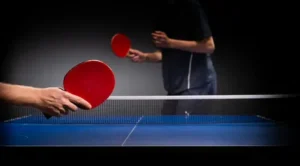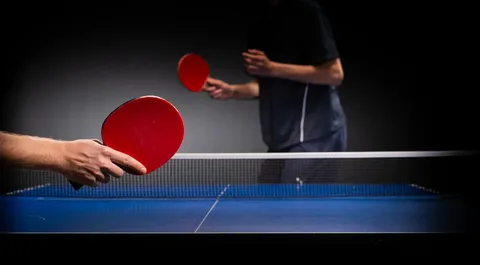How to play table tennis-Mastering the Basics and Beyond

So, you’ve decided to pick up table tennis, or maybe you’re just curious about what makes it such a fast-paced, exhilarating sport. Known for its quick reflexes and finesse, table tennis is both easy to start and challenging to master. Whether you’re looking to play recreationally or compete seriously, understanding the basics will set you on the right path. In this guide, we’ll break down everything you need to know on how to play table tennis, from the first serve to advanced strategies.
Table tennis isn’t just about hitting a small ball back and forth; it’s a game that combines strategy, precision, and agility. And believe it or not, knowing the rules and techniques can make a world of difference. So, let’s dive in and get you ready to play like a pro!
What Is Table Tennis?
Before we get into the nitty-gritty of how to play table tennis, let’s get a quick overview. Table tennis, also known as ping pong, is a fast-paced racket sport played on a rectangular table. It involves hitting a lightweight ball back and forth over a small net, with the goal of outscoring your opponent by making the ball bounce twice on their side or forcing them into a missed shot.
Table tennis is played in both singles (one player on each side) and doubles (two players per side) formats, and it’s known for its lightning-speed rallies and highly tactical gameplay. Now that you know the basics, let’s talk about how to actually start playing.
#How to Play Table Tennis: Getting Started with the Essentials
1. Understanding the Equipment
To really understand how to play table tennis, it’s essential to get familiar with the equipment you’ll be using. The right gear can make a difference, so let’s take a quick look:
Table: A regulation table tennis table measures 9 feet long, 5 feet wide, and 2.5 feet high. It’s divided by a net in the center.
Racket (or Paddle): This is used to strike the ball. Rackets consist of a blade (wooden part) and rubber on both sides. Different rubbers impact spin and speed.
Ball: The standard table tennis ball is 40mm in diameter and weighs about 2.7 grams, usually made of plastic.
Net: The net is 6 inches high and divides the table into two halves.
2. Learning the Rules
Next up in how to play table tennis is learning the basic rules:
Scoring: Games are typically played to 11 points, and a player must win by at least a two-point margin.
Serve: The ball must be thrown vertically at least 6 inches and struck behind the end line. The serve alternates every two points.
Return: After the serve, players take turns hitting the ball back and forth, making sure it bounces once on each side.
Winning: The first player to reach 11 points (with a 2-point lead) wins the game. Matches are usually played in a best-of-five or best-of-seven format.
#How to Play Table Tennis: Mastering Basic Techniques
1. The Basic Stance
Your stance forms the foundation of your game. Stand with your feet shoulder-width apart, knees slightly bent, and lean forward a bit. Your racket should be in your dominant hand, positioned at waist level, and your free hand should balance your body.
2. The Grip
There are two main grips in table tennis: the shakehand grip and the penhold grip.
Shakehand Grip: This is the most common grip, resembling a handshake. It offers versatility for both forehand and backhand strokes.
Penhold Grip: This is more common in Asian countries. It’s held similar to holding a pen, allowing for quick wrist movements but slightly limiting backhand play.
3. The Serve
The serve is a vital component of how to play table tennis. Here are a few key types of serves:
Forehand Serve: Start with the ball in your non-dominant hand, throw it up, and strike it with your racket, aiming for a low trajectory over the net.
Backhand Serve: Similar to the forehand serve, but you strike the ball from a backhand position.
Spin Serve: Adding spin to your serve can make it trickier for your opponent to return. Experiment with topspin, backspin, or sidespin to keep them guessing.
#How to Play Table Tennis: Fundamental Strokes
1. Forehand Drive
This is your go-to attacking shot. Start with your racket back, swing forward as you contact the ball, and follow through. Aim for a quick, flat shot that stays low and forces your opponent to respond quickly.
2. Backhand Drive
The backhand drive is just as important as the forehand. With your racket in front of you, swing your arm horizontally, striking the ball as it comes toward you. Use your wrist to control spin and speed.
3. Push and Chop
Pushes are defensive strokes where you make soft contact with the ball, allowing it to drop close to the net. Chops are similar but involve a downward slice, creating backspin to slow the ball down and throw off your opponent’s rhythm.
#How to Play Table Tennis: Developing Advanced Skills
1. Mastering Spin
Adding spin to your shots can be a game-changer. Spin makes it harder for your opponent to predict the ball’s movement and adds an extra layer of complexity to your rallies. The main types of spin are:
Topspin: Brush the ball upward on contact, creating a forward rotation.
Backspin: Slice downwards, causing the ball to rotate backward.
Sidespin: Swipe across the ball sideways to make it curve.
2. The Block
The block is a defensive shot used to return powerful drives. Position your racket to absorb the incoming ball’s speed and return it softly. This move is excellent for turning defense into offense.
3. Smashing
When you see a high, floating ball, it’s time to smash. Swing your racket with maximum power to send the ball toward your opponent’s side with high speed, aiming to end the rally in one shot.
#How to Play Table Tennis: Strategic Tips for Success
Control the Pace: Don’t let your opponent dictate the speed of play. Use a mix of fast and slow shots to keep them on their toes.
Target Weaknesses: Observe your opponent’s weaknesses. If their backhand is shaky, make it your target.
Keep Moving: Footwork is crucial. Try not to remain flat-footed, as quick lateral movements can help you cover the table more effectively.
FAQs About #How to Play Table Tennis
1. What’s the best way to practice table tennis alone?
Using a wall or a table tennis robot is ideal. Practicing serves and strokes repetitively will improve consistency.
2. How do I add spin to my shots?
Brush the ball with your racket at different angles. For topspin, move your racket upwards; for backspin, move it downward.
3. How can I improve my reflexes?
Practice returning serves quickly, and consider using drills designed to boost reaction time.
4. What’s the difference between shakehand and penhold grips?
The shakehand grip offers versatility for both forehand and backhand shots, while the penhold grip allows for more wrist flexibility, especially in forehand strokes.
5. How do I keep track of scoring in table tennis?
Keep tally of points until one player reaches 11 points with a 2-point lead. If the game reaches 10-10, serve changes every point.
Conclusion
Learning how to play table tennis is an exciting journey that can be as simple or as intricate as you want it to be. From mastering basic shots to developing complex spins, table tennis is a sport that offers endless opportunities for improvement. Remember, practice and consistency are key to progressing. So grab your paddle, hit the table, and get ready to level up your game. With patience, strategy, and a lot of practice, you’ll be well on your way to becoming a table tennis pro.
